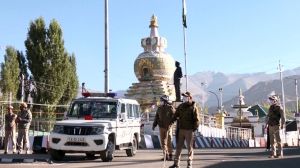US crafts strategy to crush guerrilla forces
Week by week, the guerrillas take their toll, killing Americans singly and in pairs, seeking to draw enough blood to undermine US resolve to...

Week by week, the guerrillas take their toll, killing Americans singly and in pairs, seeking to draw enough blood to undermine US resolve to remain in Iraq.
Although the resistance has shown improved organisation in the nearly three months since President Bush declared the heavy fighting over, it has failed to expand the scope of its onslaught, US military strategists say.
In an effort to crush the guerrilla forces before they expand into a broader movement, senior Defence officials have crafted an updated profile of the enemy, and a plan for dealing with it.
Pentagon strategists say they’re gaining a clearer picture of the resistance: The attackers are largely confined to the ‘‘Sunni triangle’’ of Central Iraq, failing to draw in the nation’s majority Shiite Muslim population. They’re increasingly sophisticated, probably several thousand strong—including impoverished mercenaries who will kill an American for $1,000.
The solution, according to Gen John Abizaid, the new chief of the US Central Command, is to involve Iraqis more closely in gleaning intelligence on the guerrillas then to send in a more agile force to find them.
US military strategists acknowledge that they’ll have to act fast to halt a guerrilla campaign that is increasingly desperate. ‘‘I think as we make political progress here we’ll see more violence, more desperation for a time, and it’s the nature of the enemy that we’re fighting. So we shouldn’t underestimate how hard they might fight,’’ Abizaid told reporters in Baghdad on Sunday. ‘‘And they don’t think we have the staying power to stick around.’’
He spoke hours after guerrillas opened up on a US convoy with small arms and rocket-propelled grenade fire, killing two soldiers. The attack occurred in Tall Afar, 240 miles northwest of Baghdad, the epicentre of the recent attacks. The attack brought to 151 the number of US troops killed by hostile fire since the war began March 20, eclipsing the 147 killed during the 1991 Persian Gulf War.
After months of Pentagon denials that the attackers were organised enough to merit the description, the Bush administration appears to have accepted them as guerrillas, a term Abizaid first used last week. The group consists of disgruntled mid-level leaders from Saddam’s Baath Party, Islamic extremists imported from Syria and elsewhere and terrorists drawn to American targets, Abizaid said.
The assailants, believed to include former intelligence officials, paramilitary fighters from the Fedayeen Saddam group and other Saddam loyalists, have made their goal obvious, Deputy Defence Secretary Paul D. Wolfowitz said during a visit to Iraq on Sunday: ‘‘Their aim is to restore the old regime.’’
The guerrillas, operating in groups as large as 50, communicate with a complex series of whistles and track US troops with red, green and white flares—with repeated red flares designating a ‘‘kill zone,’’ officials said. ‘‘They have increased in sophistication, and I think that there’s a certain amount of regional organisation going on, and I think they’re attempting to get more organised over time,’’ Abizaid said.
‘‘Clearly our tactics have got to change as the military strategy changes,’’ Abizaid said. ‘‘It’s a matter of focused intelligence and then troops that are agile enough to carry out missions in a manner that can cause surprise and take down the targets precisely.’’ (LAT-WP)





- 01
- 02
- 03
- 04
- 05


























